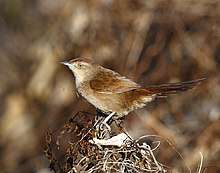Freckle-breasted thornbird
The freckle-breasted thornbird (Phacellodomus striaticollis) is a species of bird in the family Furnariidae. It is found in Argentina, Bolivia, Brazil, and Uruguay. Its natural habitats are subtropical or tropical moist lowland forest, subtropical or tropical dry shrubland, and subtropical or tropical moist shrubland. It was first described by Alcide d'Orbigny and Frédéric de Lafresnaye in 1838, from Uruguay.[2]
| Freckle-breasted thornbird | |
|---|---|
 | |
| Scientific classification | |
| Kingdom: | Animalia |
| Phylum: | Chordata |
| Class: | Aves |
| Order: | Passeriformes |
| Family: | Furnariidae |
| Genus: | Phacellodomus |
| Species: | P. striaticollis |
| Binomial name | |
| Phacellodomus striaticollis (d'Orbigny & Lafresnaye, 1838) | |
| Synonyms | |
|
Anumbius striaticollis | |
Description
The adult freckle-breasted thornbird is about 18 cm (7 in) in length and the sexes are similar. The upper parts are brown, apart from the forehead, crown, wings and tail which are chestnut, the wing feathers being tipped with black. The lores and the underparts are whitish, the throat being buff, freckled with whiter spots, and the borders of the breast and the flanks being flushed with reddish-brown. The irises are pale yellow and the beak and the legs are horn-coloured.[2] The song consists of a series of eight or ten notes, the first few being soft, moderately high-pitched and nasal, and the remainder being higher-pitched, clear and loud.[3] It can be confused with the greater thornbird (Phacellodomus ruber), but that species is larger and more rufous.[4]
Distribution and habitat
This species is native to South America where it occurs in southern Paraguay, southeastern Brazil, Bolivia, Uruguay and northeastern Argentina, at altitudes up to about 700 m (2,300 ft). It never seems to venture far from water and occurs in the undergrowth of wood edges and riverine corridors, in thickets and in scrubby marshland.[4]
Ecology
The freckle-breasted thornbird is similar to the greater thornbird in habits. Usually seen in pairs, it forages in the undergrowth and in more open marshy habitats for insects including beetles and scale insects.[5] The nest is a bulky, gourd-shaped structure with a long, curved entrance tunnel, built on a branch or in a tree fork.[6] Eggs are laid between August and January, and it is possible that there are two broods.[5]
Status
P. striaticollis is a fairly common species with a wide range. No particular threats have been recognised and the population is thought to be stable, so the International Union for Conservation of Nature has rated the bird's conservation status as being of "least concern".[1]
References
- BirdLife International (2016). "Phacellodomus striaticollis". IUCN Red List of Threatened Species. 2016: e.T22702616A93883042. doi:10.2305/IUCN.UK.2016-3.RLTS.T22702616A93883042.en. Archived from the original on 15 January 2018.
- Hudson, William Henry (1889). Argentine Ornithology: A Descriptive Catalogue of the Birds of the Argentine Republic (Complete). Library of Alexandria. p. 289. ISBN 978-1-4655-4745-3. Archived from the original on 2018-02-15.
- van Perlo, Ber (2009). A Field Guide to the Birds of Brazil. Oxford University Press. p. 486. ISBN 978-0-19-974565-4. Archived from the original on 2017-02-15.
- Ridgely, Robert S.; Tudor, Guy (2009). Field Guide to the Songbirds of South America: The Passerines. University of Texas Press. p. 96. ISBN 978-0-292-71748-0. Archived from the original on 2018-02-15.
- Remsen, J.V., Jr; Kirwan, G.M. "Freckle-breasted Thornbird (Phacellodomus striaticollis)". Handbook of the Birds of the World Alive. Lynx Edicions, Barcelona. Retrieved 4 January 2018.CS1 maint: multiple names: authors list (link)
- "Freckle-breasted Thornbird (Phacellodomus striaticollis)". Neotropical Birds. Cornell Lab of Ornithology. Archived from the original on 5 January 2018. Retrieved 4 January 2018.
External links
| Wikimedia Commons has media related to Phacellodomus striaticollis. |
